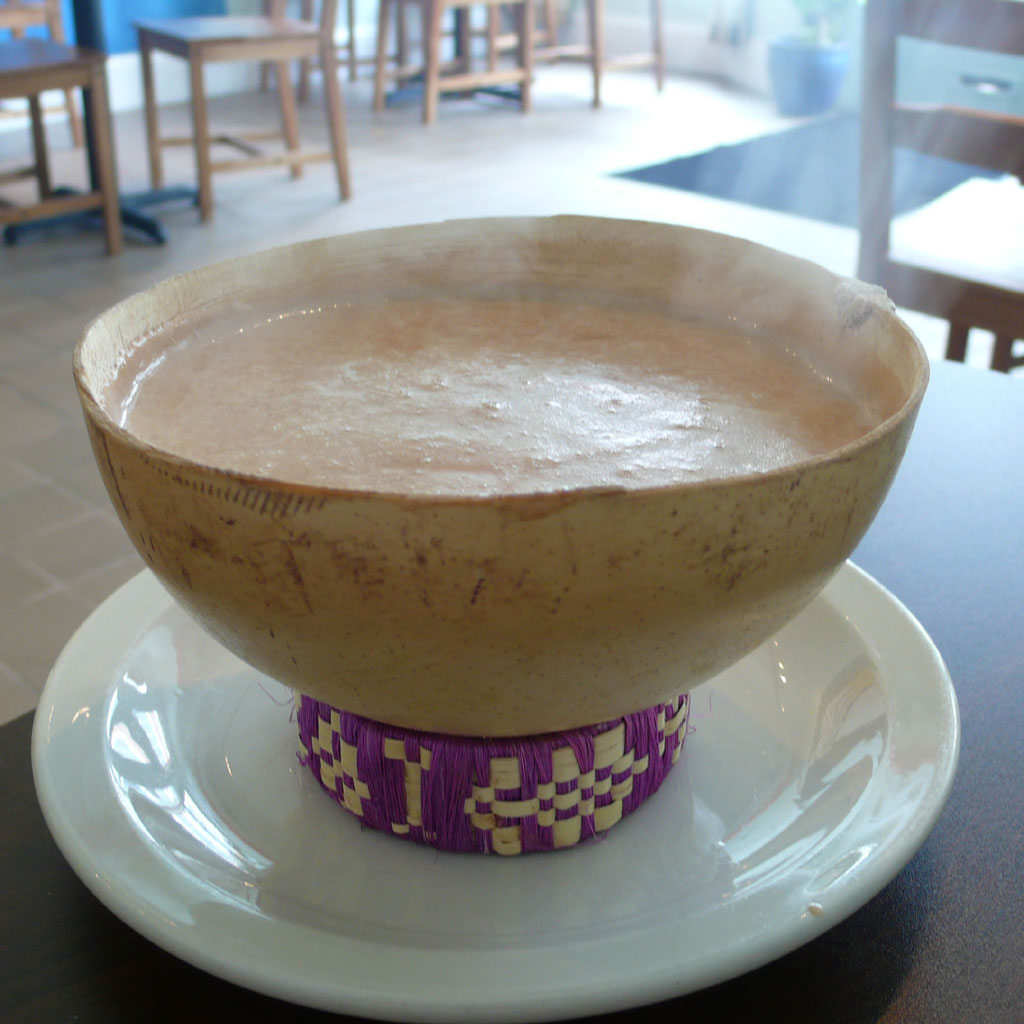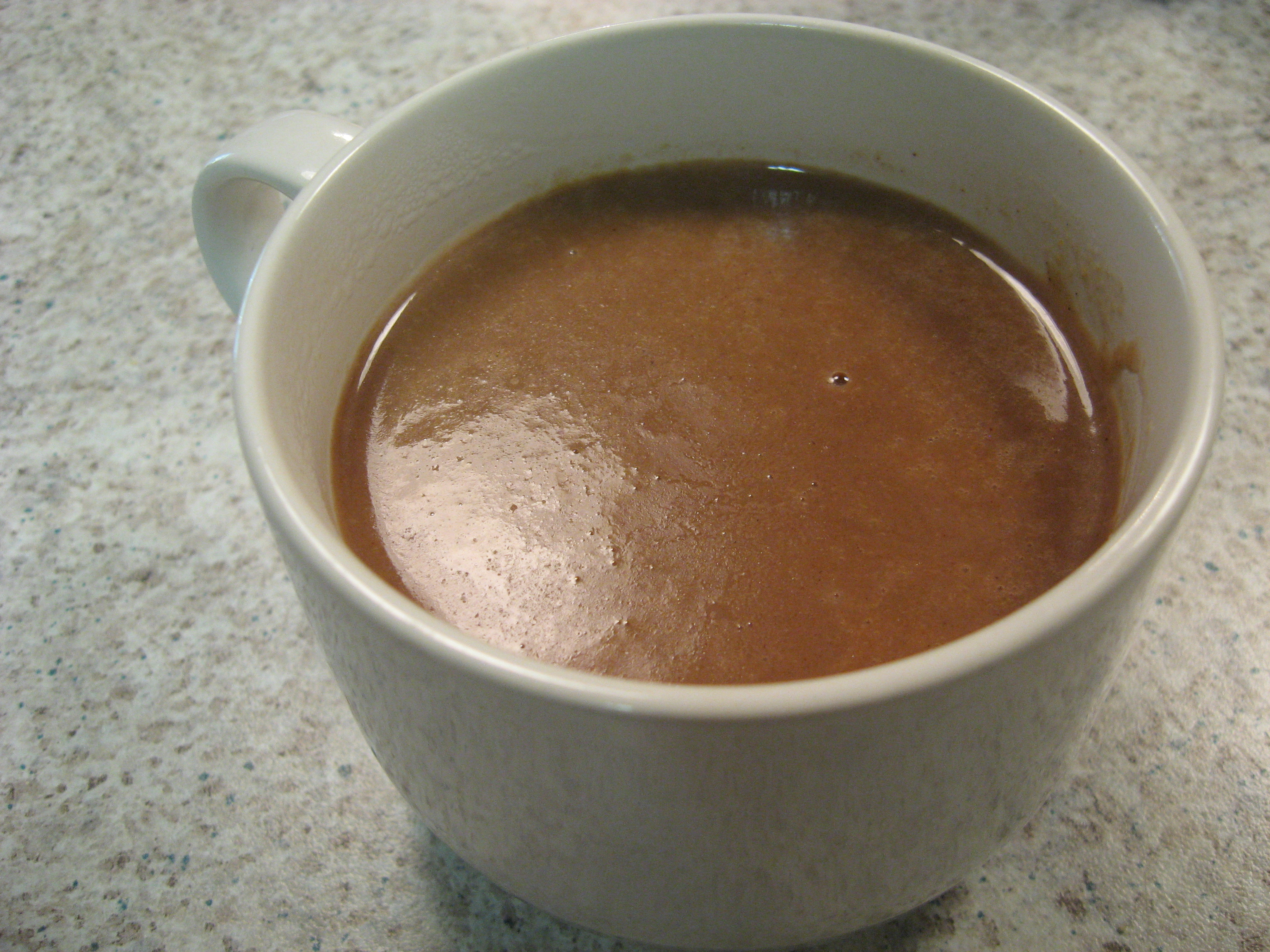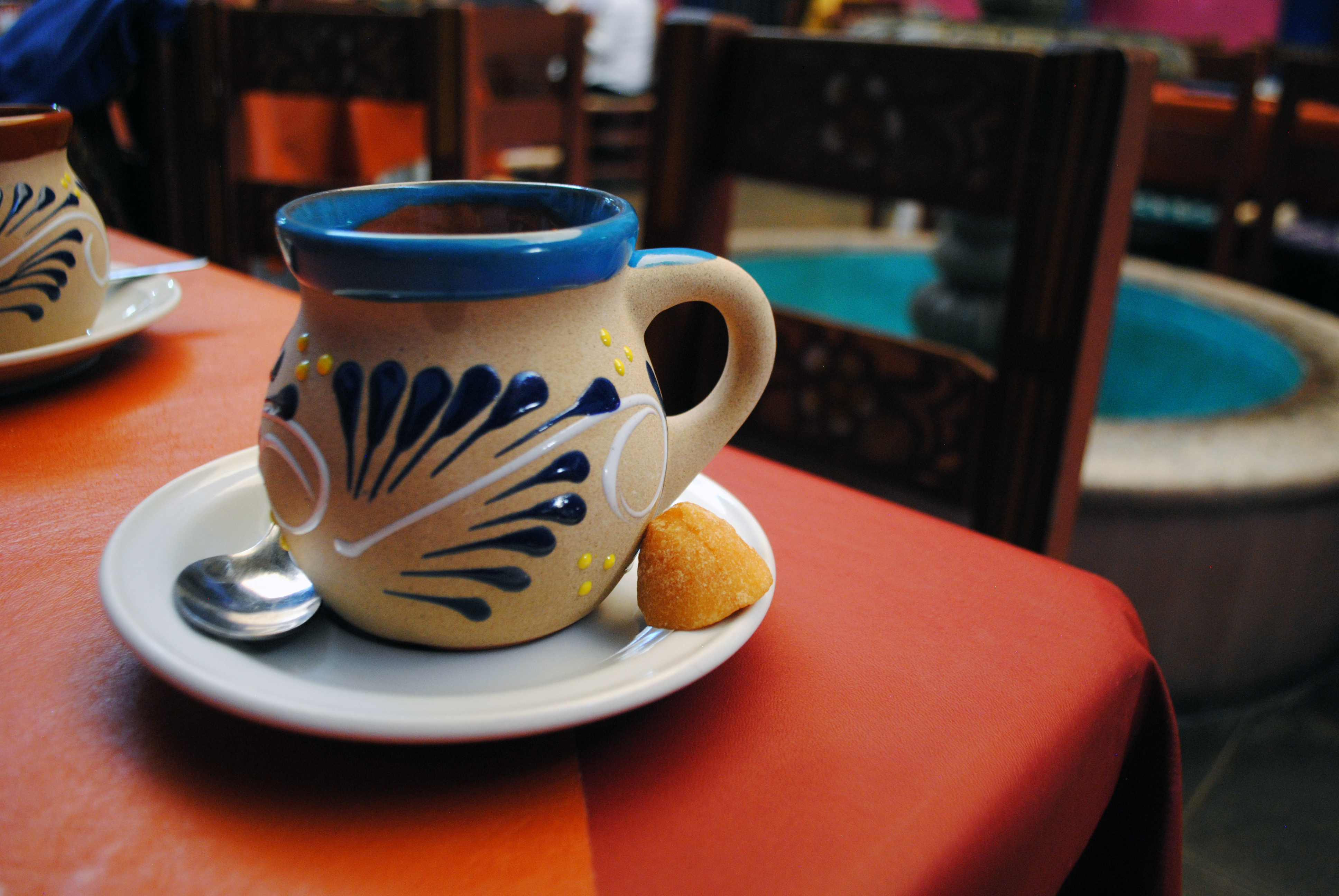|
Atole
''Atole'' (, from Nahuatl '' ātōlli'' ), also known as ''atolli'' and ''atol de elote'', is a traditional hot corn- and masa-based beverage of Mexican origin. Chocolate ''atole'' is known as ''champurrado'' or ''atole''. It typically accompanies tamales, and is very popular during Day of the Dead (observed November 2) and ''Las Posadas'' (Christmas holiday season). In Mexico In Mexico, the drink typically includes'' masa ''(corn hominy flour), water, ''piloncillo'' (unrefined cane sugar), cinnamon, vanilla, and optional chocolate or fruit. The mixture is blended and heated before serving. ''Atole'' is made by toasting ''masa'' on a ''comal'' (griddle), then adding water that was boiled with cinnamon sticks. The resulting blends vary in texture, ranging from a porridge to a very thin, liquid consistency. ''Atole'' can also be prepared with rice, wheat, or oatmeal in place of masa. In northern Mexico, a variation is also made using ''pinole'' (sweetened toasted corn meal). ... [...More Info...] [...Related Items...] OR: [Wikipedia] [Google] [Baidu] |
Champurrado
Champurrado is a chocolate-based ''atole'', a warm and thick Mexican beverage. It is prepared with either '' masa de maíz'' (lime-treated corn dough),'' masa harina'' (a dried version of this dough), or corn flour (simply very finely ground dried corn, especially local varieties grown for ''atole''); ''piloncillo''; water or milk; and occasionally containing cinnamon, anise seed, or vanilla. Ground nuts, orange zest, and egg can also be added to thicken and enrich the drink. ''Atole'' drinks are whipped up using a wooden whisk called a '' molinillo''. The whisk is rolled between the palms of the hands, then moved back and forth in the mixture until it is aerated and frothy; a blender may also be used. Champurrado is traditionally served with ''churros'' in the morning as a simple breakfast or as a late afternoon snack. Champurrado is also very popular during Day of the Dead and at ''Las Posadas'' (during the Christmas season), where it is served alongside ''tamales''. Champur ... [...More Info...] [...Related Items...] OR: [Wikipedia] [Google] [Baidu] |
Champurrado
Champurrado is a chocolate-based ''atole'', a warm and thick Mexican beverage. It is prepared with either '' masa de maíz'' (lime-treated corn dough),'' masa harina'' (a dried version of this dough), or corn flour (simply very finely ground dried corn, especially local varieties grown for ''atole''); ''piloncillo''; water or milk; and occasionally containing cinnamon, anise seed, or vanilla. Ground nuts, orange zest, and egg can also be added to thicken and enrich the drink. ''Atole'' drinks are whipped up using a wooden whisk called a '' molinillo''. The whisk is rolled between the palms of the hands, then moved back and forth in the mixture until it is aerated and frothy; a blender may also be used. Champurrado is traditionally served with ''churros'' in the morning as a simple breakfast or as a late afternoon snack. Champurrado is also very popular during Day of the Dead and at ''Las Posadas'' (during the Christmas season), where it is served alongside ''tamales''. Champur ... [...More Info...] [...Related Items...] OR: [Wikipedia] [Google] [Baidu] |
Day Of The Dead
The Day of the Dead ( es, Día de Muertos or ''Día de los Muertos'') is a holiday traditionally celebrated on November 1 and 2, though other days, such as October 31 or November 6, may be included depending on the locality. It is widely observed in Mexico, where it largely developed, and is also observed in other places, especially by people of Mexican heritage. Although related to the simultaneous Christian remembrances for Hallowtide, it has a much less solemn tone and is portrayed as a holiday of joyful celebration rather than mourning. The multi-day holiday involves family and friends gathering to pay respects and to remember friends and family members who have died. These celebrations can take a humorous tone, as celebrants remember funny events and anecdotes about the departed. Traditions connected with the holiday include honoring the deceased using calaveras and marigold flowers known as ''cempazúchitl'', building home altars called ''ofrendas'' with the favorite ... [...More Info...] [...Related Items...] OR: [Wikipedia] [Google] [Baidu] |
Masa
''Masa'' (or ''masa de maíz'') (; ) is a maize dough that comes from ground nixtamalized corn. It is used for making corn tortillas, '' gorditas'', ''tamales'', '' pupusas'', and many other Latin American dishes. It is dried and powdered into a flour form called ''masa harina''. Masa is reconstituted from masa harina by mixing with water before use in cooking. In Spanish, ''masa harina'' translates to "dough flour", which can refer to many other types of dough. Preparation Field corn grain is dried and then treated by cooking the mature, hard grain in a diluted solution of slaked lime (calcium hydroxide) or wood ash, and then letting it soak for many hours. The soaked maize is then rinsed thoroughly to remove the unpalatable flavor of the alkali. This process is nixtamalization, and it produces hominy, which is ground into a relatively dry dough to create fresh masa. The fresh masa can be sold or used directly, or can be dehydrated and blended into a powder to create masa ha ... [...More Info...] [...Related Items...] OR: [Wikipedia] [Google] [Baidu] |
Hominy
Hominy (Spanish: maíz molido; literally meaning "milled corn") is a food produced from dried maize (corn) kernels that have been treated with an alkali, in a process called nixtamalization ( is the Nahuatl word for "hominy"). "Lye hominy" is a type of hominy made with lye. History The process of nixtamalization has been fundamental to Mesoamerican cuisine since ancient times. The lime used to treat the maize can be obtained from several different materials. Among the Lacandon Maya who inhabited the tropical lowland regions of eastern Chiapas, the caustic powder was obtained by toasting freshwater shells over a fire for several hours. In the highland areas of Chiapas and throughout much of the Yucatán Peninsula, Belize River valley and Petén Basin, limestone was used to make slaked lime for steeping the shelled kernels. The Maya used nixtamal to produce beers that more resembled '' chicha'' than '' pulque''. When bacteria were introduced to nixtamal it created a typ ... [...More Info...] [...Related Items...] OR: [Wikipedia] [Google] [Baidu] |
Masa
''Masa'' (or ''masa de maíz'') (; ) is a maize dough that comes from ground nixtamalized corn. It is used for making corn tortillas, '' gorditas'', ''tamales'', '' pupusas'', and many other Latin American dishes. It is dried and powdered into a flour form called ''masa harina''. Masa is reconstituted from masa harina by mixing with water before use in cooking. In Spanish, ''masa harina'' translates to "dough flour", which can refer to many other types of dough. Preparation Field corn grain is dried and then treated by cooking the mature, hard grain in a diluted solution of slaked lime (calcium hydroxide) or wood ash, and then letting it soak for many hours. The soaked maize is then rinsed thoroughly to remove the unpalatable flavor of the alkali. This process is nixtamalization, and it produces hominy, which is ground into a relatively dry dough to create fresh masa. The fresh masa can be sold or used directly, or can be dehydrated and blended into a powder to create masa ha ... [...More Info...] [...Related Items...] OR: [Wikipedia] [Google] [Baidu] |
Porridge
Porridge is a food made by heating or boiling ground, crushed or chopped starchy plants, typically grain, in milk or water. It is often cooked or served with added flavourings such as sugar, honey, (dried) fruit or syrup to make a sweet cereal, or it can be mixed with spices, meat or vegetables to make a savoury dish. It is usually served hot in a bowl, depending on its consistency. Oat porridge, or oatmeal, is one of the most common types of porridge. Gruel is a thinner version of porridge. Type of grains The term "porridge" is often used specifically for oat porridge (oatmeal), which is typically eaten for breakfast with salt, sugar, fruit, milk, cream or butter and sometimes other flavourings. Oat porridge is also sold in ready-made or partly cooked form as an instant breakfast. Other grains used for porridge include rice, wheat, barley, corn, triticale and buckwheat. Many types of porridge have their own names, such as congee, polenta, grits and kasha. Conventional ... [...More Info...] [...Related Items...] OR: [Wikipedia] [Google] [Baidu] |
Piloncillo
Panela () or rapadura (Portuguese pronunciation: ) is an unrefined whole cane sugar, typical of Central and Latin America. It is a solid form of sucrose derived from the boiling and evaporation of sugarcane juice. Panela is known by other names in Latin America, such as ''chancaca'' in Chile, Bolivia, and Peru, ''piloncillo'' in Mexico (where ''panela'' refers to a type of cheese, ''queso panela''). The name ''piloncillo'' means "little loaf", because of the traditional shape in which this smoky, caramelly, and earthy sugar is produced. Just like brown sugar, two varieties of ''piloncillo'' are available; one is lighter (''blanco'') and one darker (''oscuro''). Unrefined, it is commonly used in Mexico, where it has been around for at least 500 years. Made from crushed sugar cane, the juice is collected, boiled, and poured into molds, where it hardens into blocks. Elsewhere in the world, the word ''jaggery'' describes a similar foodstuff. Both are considered non-centrifugal ca ... [...More Info...] [...Related Items...] OR: [Wikipedia] [Google] [Baidu] |
Tamale
A tamale, in Spanish tamal, is a traditional Mesoamerican dish made of masa, a dough made from nixtamalized corn, which is steamed in a corn husk or banana leaf. The wrapping can either be discarded prior to eating or used as a plate. Tamales can be filled with meats, cheeses, fruits, vegetables, herbs, chilies, or any preparation according to taste, and both the filling and the cooking liquid may be seasoned. ''Tamale'' is an anglicized version of the Spanish word (plural: ). comes from the Nahuatl . The English "tamale" is a back-formation of , with English speakers interpreting the ''-e-'' as part of the stem, rather than part of the plural suffix ''-es''. Origin Tamales originated in Mesoamerica as early as 8000 to 5000 BC. The preparation of tamales is likely to have spread from the indigenous cultures in Guatemala and Mexico to the rest of Latin America. According to archaeologists Karl Taube, William Saturno, and David Stuart, tamales may date from arou ... [...More Info...] [...Related Items...] OR: [Wikipedia] [Google] [Baidu] |
Comfort Food
Comfort food is food that provides a nostalgic or sentimental value to someone, and may be characterized by its high caloric nature, high carbohydrate level, or simple preparation. The nostalgia may be specific to an individual, or it may apply to a specific culture. Definition and history The term ''comfort food'' has been traced back at least to 1966, when the '' Palm Beach Post'' used it in a story: "Adults, when under severe emotional stress, turn to what could be called 'comfort food'—food associated with the security of childhood, like mother's poached egg or famous chicken soup." According to a research by April White at JSTOR, it might have been Liza Minnelli who used the term for the first time in its modern meaning in an interview, admitting to craving a hamburger. When the term first appeared, newspapers used it in quotation marks. In the 1970s, the most popular comfort food in the United States were various potato dishes and chicken soup, but even at t ... [...More Info...] [...Related Items...] OR: [Wikipedia] [Google] [Baidu] |
New Mexico
) , population_demonym = New Mexican ( es, Neomexicano, Neomejicano, Nuevo Mexicano) , seat = Santa Fe, New Mexico, Santa Fe , LargestCity = Albuquerque, New Mexico, Albuquerque , LargestMetro = Albuquerque metropolitan area, Tiguex , OfficialLang = None , Languages = English language, English, Spanish language, Spanish (New Mexican Spanish, New Mexican), Navajo language, Navajo, Keres language, Keres, Zuni language, Zuni , Governor = , Lieutenant Governor = , Legislature = New Mexico Legislature , Upperhouse = New Mexico Senate, Senate , Lowerhouse = New Mexico House of Representatives, House of Representatives , Judiciary = New Mexico Supreme Court , Senators = * * , Representative = * * * , postal_code = NM , TradAbbreviation = N.M., N.Mex. , area_rank = 5th , area_total_sq_mi = 121,591 , area_total_km2 = 314,915 , area_land_sq_mi = 121,298 , area_land_km2 = 314,161 , area_water_sq_mi = 292 , area_water_km2 = 757 , area_water_percent = 0.24 , ... [...More Info...] [...Related Items...] OR: [Wikipedia] [Google] [Baidu] |
Beverage
A drink or beverage is a liquid intended for human consumption. In addition to their basic function of satisfying thirst, drinks play important roles in human culture. Common types of drinks include plain drinking water, milk, juice, smoothies and soft drinks. Traditionally warm beverages include coffee, tea, and hot chocolate. Caffeinated drinks that contain the stimulant caffeine have a long history. In addition, alcoholic drinks such as wine, beer, and liquor, which contain the drug ethanol, have been part of human culture for more than 8,000 years. Non-alcoholic drinks often signify drinks that would normally contain alcohol, such as beer, wine and cocktails, but are made with a sufficiently low concentration of alcohol by volume. The category includes drinks that have undergone an alcohol removal process such as non-alcoholic beers and de-alcoholized wines. Biology When the human body becomes dehydrated, a person experiences thirst. This craving of f ... [...More Info...] [...Related Items...] OR: [Wikipedia] [Google] [Baidu] |




.jpg)


.jpg)
